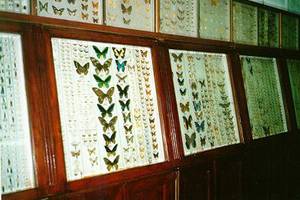Forest Zoology, Hunting and Entomology Museum, Saint Petersburg
Community and Forum → Blog → Forest Zoology, Hunting and Entomology Museum, Saint Petersburg
Lev Bely, 06.09.2012 22:30

One more butterfly hunting season is nearly over and it gradually turnes into home sessions with sorting the stuff, repairing nets and studying identification guides. But also this is the perfect time for visiting museums where the season is open all year round: to gaze for hours at bugs, compare specimens, count insect legs — namely, to make yourself ready for the next season hard work.
There is such a museum in Saint Petersburg (Russia), named Forest Zoology, Hunting and Entomology Museum, at the S. M. Kirov Saint Petersburg State Forest Technical University.
The museum is located right in the main building of the university, where it occupies four exhibit halls at the forestry faculty. Its history goes back to 1859 when it started as a small study room for entomology students. The first insect collection included 1300 specimens, to see which in 1859 you should've had a long trip to Liissin Korppus village outside the city.
Forest and its pests are obviously the main themes there. Back in time to the Soviets, the museum was directed by Soviet entomologist M. N. Rimsky-Korsakov who arranged entomological expeditions over the whole Soviet Union. It wasn't recreation trips, rather comprehensive research work: in the post-war period abandoned forestries suffered from the pest invasion, and such expeditions were supposed to investigate lands and create new ways to reduce the pest population and protect forests.
Today the museum collection consists of about 5000 insect specimens. Eye on the same pests which seem to destroy whatever they find destroyable: leaves, tree bark as well as the very forest itself, which they can literally devour in the blink of an eye. So it's all about timber. Specimens are all properly systematized and marked: you can see there lovers, or rather, pests, of coniferous woods, then have a look at hardwoods and relative pests. While the third ones are definitely not going to leave timber ever, you may get entirely charmed with pests which ascetically refuse anything but fruits and seeds. So the forest in all its parts turns out to be the good food.
The museum states that its collection of forest pests is unique and there is no another of the kind in the whole world.
If you still hesitate which name sounds better, cockchafer or may-bug, or even billy witch, there you may probably sort the issue out by learning that it's also called melolontha. Yet the museum is rather concerned of the beetle itself which is a most dangerous pine pest. Albeit, it was successfully beaten, what the museum demonstrates from recently. Thrilling plot: cockchafer singed its wings because of its own weakness. Worth seeing with your own eyes!
There is also displayed some curious stuff like what pests leave behind, in case when they left anything. A tree trunk “decorated” by ornamental wood carvers — bark beetles.
The story of this wonderful museum might not be here if it hadn't a huge butterfly collection. Butterflies don't even need to ornate tree trunk or anything. They look so gorgeous themselves:)
Forest Zoology, Hunting and Entomology Museum: Institutsky side-street 5, Saint Petersburg, Russia. Free entrance, visits must be arranged in advance. Guided tours available.
S. M. Kirov Saint Petersburg State Forest Technical University, http://ftacademy.ru, Museums in Russia, http://www.museum.ru
Photo: at the museum, http://ftacademy.ru
All the rest posts on: Pests, collecting, education, Russia
Comments
New comment
Note: you should have a Insecta.pro account to upload new topics and comments. Please, create an account or log in to add comments.
* Our website is multilingual. Some comments have been translated from other languages.
Random species of the website catalog
News
- 31.12.2024: Если нужно загрузить на сайт много фотографий
- 10.12.2024: Новое поле в «Поиске энтомологов»
- 05.12.2024: Insecta.pro maps: filter by taxon
New photos (14.01.2025)
Fresh from the community
- 8:31, V. Kolesnikov: Lygaeus murinus?...
- 20:53, P. Khramov: Not identified → Callistege mi / Co...
- 16:25, N. Grebennikov: Callistege mi....
Popular insects
Recommended blog topics
- Meanwhile, in Kotelnich
- The insects exhibition in Kotlas
- New Zealand's lepidoptera: Aenetus virescens ghost moth



























